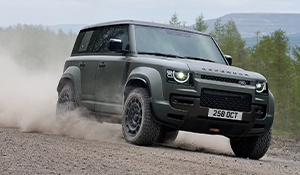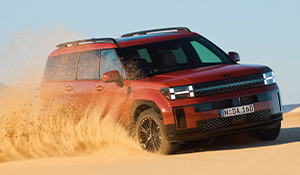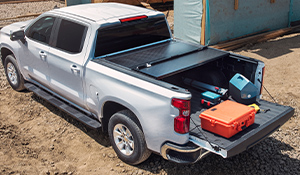REVIEW – 2021 ISUZU D-MAX
Credits via Practical Motoring
Isuzu has a loyal following because it builds solid, reliable utes and 4×4 wagons that are often seen in some of the most remote areas of Australia. True, it hasn’t gone anywhere near selling the numbers of the Toyota Hilux and Ford Ranger, but this new model is going to rattle the establishment’s tree and pick up plenty of ute shoppers. It might even nab rusted on Ranger and Hilux fans that are sniffing around for something that feels and looks different in a good way, is solidly built, and gains some improvements.

Since Isuzu’s last generation effort building a ute in collaboration with GM, its new path sees it the lead in a partnership with Mazda. The latter only restyles the outer shell and some interior pieces for the upcoming BT-50, with Isuzu building the chassis and supplying the drivetrain, which is a good thing. In this instance, we see a new engine – it’s in the 4JJ family but with a new block , head, pistons, and more.

And Mazda likely helped push Isuzu in the right direction when it came to requirements they had, like safety technology and interior tech and packaging, which have taken one giant leap over the old model. That’s not to discount Isuzu’s own intentions with this D-Max though, as local executives have been telling us for years they want a modern five-star ANCAP-rated ute that will appeal to both private and fleet buyers where big sales deals exist. It has done all of that except we don’t know the ANCAP rating yet (ANCAP has been testing it since last month).

Moving on, the generational change brings a stiffer chassis that’s grown wider. It’s not as long, measuring 5280mm (down by 15mm), but has a longer wheelbase at 3125mm (up 30mm). The suspension, a traditional coil-sprung front strut arrangement and three-leaf spring rear carry on, but all revised, the new rear leafs providing a further 30mm travel, and a claim of better ride quality, off-road ability, and reduced NVH (noise, vibration and harshness).

It’s not just whimsical either. The new ute gives Isuzu a position that, without us back-to-back testing all utes in the segment, we’d say is a solid top-three ute. It does some things better than others and some things about the same, making this one sweet new option for ute buyers. Unfortunately, the price is up, and that’s an area that Isuzu once stole the limelight.

How much does the new Isuzu D-Max cost?
With a much more polished ute Isuzu moves ‘upmarket’ in the ute world. Pricing at the entry point is actually still under $30k for a 4×2 cab-chassis loaded with a safety suite of neat technology, but further up we see price fluctuations of almost $8000 when looking at the retail price sheet…though in reality this top-spec X-Terrain priced at $62,900 is being sold officially at $58,990 driveaway, which means it undercuts its rivals. They’d be the Ford Ranger Wildtrak and Toyota Hilux Rogue. The cheapest 4×4 dual-cab D-Max is the $47,900 plus on-roads SX – review coming soon.

All D-Max’s are covered by a six-year/150,000km warranty, a cost-option seven-year capped price servicing plan and there’s seven-year roadside assistance if you service at an Isuzu dealership. That’s all very competitive and bests all but Mitsubishi’s seven-year warranty deal and SsangYong’s seven-year warranty standard.

What’s the new Isuzu D-Max like inside?
It’s a night and day difference inside and coming from the old model you wouldn’t know it if it wasn’t for the badge on the steering wheel. Gone are the hard-wearing plastics which were a bit scratchy in appearance for a mix of leather, soft-touch materials and hardwearing coverings where it counts. The top of the dash is stitched soft elements that complement the shape nicely, as do the metallic buttons for climate control and new gearshift design. The centre console remains large and the handbrake a mechanical release rather than electronic, with a decently large centre console behind it.

The most obvious change is the infotainment, which is huge. Measuring 9.0-inches on the diagonal, it eclipses most units on the market and it’s very smart to use. It has Bluetooth, Android Auto and Apple CarPlay, with wireless Apple CarPlay making it the first in the segment to offer cordless connection for app use. And not just big, the screen has a 144ppi resolution, which is to say it looks crisp and sharp. The standard software doesn’t look flash but you’ll no doubt be using Android or Apple, which works really well. And the stock system is more about smarts: you can change settings for just about anything, including brightness, contrast, colour and more for the standard screens, reversing camera, and Apple/Android screens separately. Glare is low and touch sensitivity on point.

Behind the steering wheel is a 7.0-inch digital display that provides guidance for the digital speedo, adaptive cruise control, lane-keeping assist, speed sign recognition, and a raft of settings. It is here that you can turn of the bing bong sounds for the automatic speed sign recognition, lane departure warning and other alerts. Options include a less invasive flash on the screen which works well. When AEB is triggered it flashes via the red light bar tucked between the cowl and windscreen.
The reversing camera image is fine but not leading. Lacking is a 360-degree camera and seat warmers, the latter we’ve asked the question ‘why?’ and have been told the factory has been notified; the BT-50 has seat warmers upfront.

Beyond that, the seat for the driver has electric adjustment and there is both tilt and reach adjustment on the steering wheel, making this a far comfier arrangement than before. The leather is of a nice quality in the X-Terrain and stitching in around the seams, matching the upper dash treatment. Room for front occupants is capacious and it’s a good setup for lapping longs kays in. In particular, buttons driving controls are placed on the steering wheel or a convenient spot nearby. The four-high and low dial remains near the gearshift, tucked up on the console stack.

The rear’s also a well-equipped area for kids and surprisingly roomy for adults. Rear air vents in the centre console stack are rare in this segment and the footwell space has a good amount of room. For those with kids, the isofix points on the outer seats and factory-standard top tether anchors are great – just mind that the manual says not to use them for the centre seat. Our three-year-old in the back had plenty of space once buckled in.
Moving to the tray is a lockable roller cover with tub liner. Plenty of anchor points located around the tub are useful for arranging cargo safely and strapping in. The tailgate is manually operable and doesn’t have struts, so it doesn’t soft drop like some.

What’s the new Isuzu D-Max engine like?
We touched on the reliability of previous D-Max and a fair chunk of that comes from the underpowered lump up front. In this generation we see the same 2999cc swept capacity but in a new engine block with a new head, pistons, injectors, turbocharger, and more. The 3.0-litre diesel turbo for this generation is therefore designated 4JJ3-TCX, moving on from the older 4JJ1-TC in other ways than displacement.

Power and torque, therefore, are up too, but not by much. Previous output was 130kW and 430Nm which now looks like 140kW (still at 3600rpm) and 450Nm, through either the six-speed manual or six-speed Aisin automatic.
That’s not a big difference, and both outputs remain lower compared to the Ford Ranger’s new 2.0-litre twin-turbo and Toyota’s 2.8-litre update arriving soon. But full torque is delivered from 1600rpm, 400rpm earlier than before, which gives plenty of pulling power in the real world. The six-speed auto is also nicely geared, and the ratios provide a thoughtful gear spread for initial acceleration around town and towing and cruising on the highway.

The other thought should be for lower stress on the engine which is why we hear many positive reports from our readers and the industry in regard to older Isuzu’s keeping on for a long time. Though if you want some extra get up and go there are plenty of tuners familiar with the 4JJ’s potential.
You can also appreciate the relaxed nature and tone of the 3.0L which sometimes drops into idle on flats and downhills….and can’t be heard. At first, I actually thought it had gone into some sort of start-stop mode.
Service intervals on the Isuzu D-Max are every 15,000km or 12 months, whichever comes first, and there is a seven-year capped-price service plan.

What’s the new Isuzu D-Max like to drive?
There are many changes underneath the skin and they all add up to an easier to drive 4×4 ute with a comfier ride. Notable changes are the move from hydraulic power-assisted steering to electric power assistance, and the new three-leaf sprung rear-end, including new dampers.

Steering the Isuzu is a cinch thanks to the new electrically-assisted rack and it really helps when you get off-road and crawl about. On the road, it’s up there with our benchmark the Ranger, and city driving, in particular, has improved a long way. Feedback remains similar but without much disturbance on bumps, and mid-corner bump while cornering settles quickly and feels safer. The turning circle is 12.5 metres – reduced over the older (narrower) model.
At the rear, the three-leaf spring design continues to do a good job. This X-Terrain has a 970kg payload capacity and not the 1300kg of the cab chassis, but still, for about a one-tonne ute this car feels well resolved for a ladder-frame chassis on leafs. The front-end is compliant too, and the 265/60 Bridgestone Dueler HT 684 II tyres on 18-inch alloys ride well. Off-road they’re not much chop when its wet and boggy, which we experienced, but we were able to recover out of a few muddy situations.

When stuck, four-low is the go, accessed again in neutral. Part-time four high is accessed on the fly at speed up to 100km/h. But in four-low we now have a rear locking differential and traction control, though both can’t be used together. None the less, the inclusion of a locking diff on all 4×4 models is a solid upgrade and the driveline is smooth to crawl in at slow speed, which wasn’t quite the case previously. We’d point some of this onto the six-speed auto that’s an upgrade over the older unit and shifts in all situations quickly and smoothly.
Added to off-road credentials is a deeper 800mm wading depth thanks to revisions on the intake side. We didn’t tow with the Isuzu D-Max (yet), but the rating is 3500kg braked. We’ll give a full briefing on the D-Max’s towing capabilities another time. Front brakes measure a large 320mm so we expect a solid performance in that area.

How safe is the new Isuzu D-Max?
A wonderfully long list (for a ute!) of standard technology systems makes its way into the D-Max and it starts with a dual-camera sensor system produced by Japanese manufacturer Hitachi. As the cameras are mounted high on the windscreen things like AEB and adaptive cruise control work with any of the available Isuzu front bars.
The system itself is quite good and we had AEB work smartly and without false triggers. Sometimes we test cars that will initiate AEB when tricked by parked vehicles not in line with the trajectory of the vehicle.

To be honest, Isuzu and safety assistance systems have no history, so it was lifting to see it all work well in action. Lane-keeping assist includes steering assist which automatically centers the vehicles and works best on highways and freeways. The adaptive cruise control was spot on when following traffic with the exception of a couple kilometers creep over the set limit going down a hill. The blind-spot monitor is handy too when you have a large load in the back, and the automatic speed sign recognition was mostly accurate to the signed speed limits. The only annoyance we had was the default binging from the safety systems, but everything can be tailored via settings on the dash screen (you must be in park to access this screen and not driving).
There’s also a centre airbag between the front occupants, a first in the segment.

Is the new Isuzu D-Max a good ute?
We’re thoroughly impressed by Isuzu’s new generation ute and it rises to the top of the ladder alongside the Ranger and Hilux. For the money (the driveaway deal here is appealing) the D-Max is a must look and things like the added safety, roomy cabin, premium appointments, and kid-friendly rear seat will make this the Aussie touring ute of choice for many.









